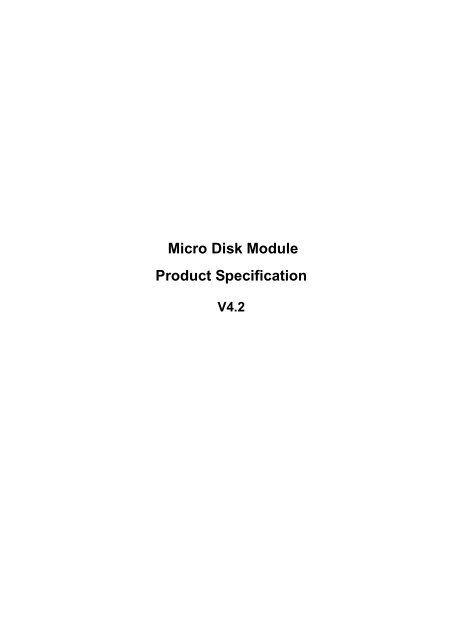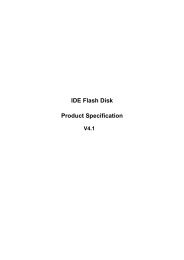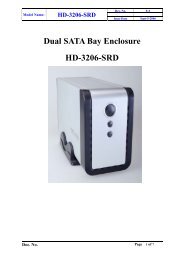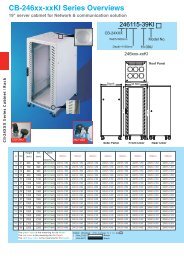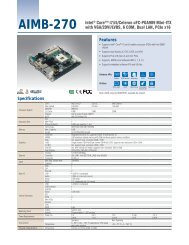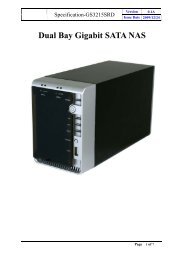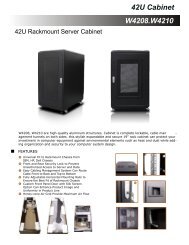Micro Disk Module Product Specification - Comix.com.tw
Micro Disk Module Product Specification - Comix.com.tw
Micro Disk Module Product Specification - Comix.com.tw
Create successful ePaper yourself
Turn your PDF publications into a flip-book with our unique Google optimized e-Paper software.
<strong>Micro</strong> <strong>Disk</strong> <strong>Module</strong><br />
<strong>Product</strong> <strong>Specification</strong><br />
V4.2
Contents:<br />
A. <strong>Product</strong> Information ...............................................................1<br />
B. System Features.....................................................................2<br />
C. <strong>Specification</strong>s .........................................................................3<br />
D. Pin Assignments and Signal Descriptions ..........................4<br />
E. System Power Consumption.................................................6<br />
F. Power Management................................................................6<br />
G. Electrical <strong>Specification</strong>s ........................................................7<br />
H. DC Characters.........................................................................8<br />
I. AC Characters.........................................................................9<br />
J. Hardware Function ...............................................................10<br />
K. <strong>Product</strong> Model and Physical <strong>Specification</strong> ........................16<br />
L. Part Number Decode ............................................................22
A. <strong>Product</strong> Information<br />
The <strong>Micro</strong> <strong>Disk</strong> <strong>Module</strong> is solid-state design and IDE <strong>com</strong>patible. It is<br />
an ideal replacement for standard IDE hard disk. It’s a solid-state design<br />
offers no seek errors even under extreme shock and vibration conditions.<br />
The <strong>Micro</strong> <strong>Disk</strong> <strong>Module</strong> is extremely small and highly suitable for rugged<br />
environments, thus providing an excellent solution for mobile applications<br />
with space limitations. It is fully <strong>com</strong>patible with all consumer applications<br />
designed for data storage, allowing simple use for the end user. The <strong>Micro</strong><br />
<strong>Disk</strong> <strong>Module</strong> is O/S independent, thus offering an optimal solution for<br />
embedded systems operating in non-standard <strong>com</strong>puting environments. It<br />
provides memory storage for mobile <strong>com</strong>puting applications, consumer<br />
electronics and embedded systems.<br />
The <strong>Micro</strong> <strong>Disk</strong> <strong>Module</strong> is IDE <strong>com</strong>patible and offering various<br />
capacities. It has low power consumption and can operate from a single<br />
3.3/5.0 Volt power supply. The operating temperature grade is <strong>com</strong>mercial<br />
operating temperature grade (0℃~+70℃) and industrial operating<br />
temperature grade (-40℃~+85℃). Optional vertical type with case and<br />
horizontal type include righ<strong>tw</strong>ards side or lef<strong>tw</strong>ards side.<br />
Page 1
B. System Features<br />
Industry ATAPI-5 Standard Compliant.<br />
Max Capacity supported: 16GByte.<br />
Optional designs for vertical type and horizontal type<br />
High reliability assured based on the internal ECC (Error Correcting<br />
Code) function.<br />
Reliable wear-leveling algorithm to ensure the best of flash endurance.<br />
Auto Standby and Sleep Mode supported.<br />
Flexible file system structure.<br />
Dual Channel operation supported for performance enhancement.<br />
Automatic Recognition and Initialization of flash devices.<br />
Excellent performance supporting Ultra DMA Mode 4.<br />
Capacity supported: 128MB, 256MB, 512MB, 1GB, 2GB, 4GB,<br />
8GB, 16GB<br />
Page 2
C. <strong>Specification</strong>s<br />
Compatibility PC ATA and True IDE<br />
Flash Technology NAND Type SLC Flash Memory Base<br />
40-pin 44-pin<br />
Vertical Type Vertical Type<br />
Form Factor<br />
Horizontal Type in Lef<strong>tw</strong>ard Horizontal Type in Lef<strong>tw</strong>ard<br />
Horizontal Type in Righ<strong>tw</strong>ard Horizontal Type in Righ<strong>tw</strong>ard<br />
Connector Types 2.54mm Female 2.00mm Female<br />
Master/Slave Setup By Jump Setup By Jump<br />
Hardware protect<br />
System Performance<br />
Setup By Jump Setup By Jump<br />
Data Transfer Mode PIO Mode 4 or UDMA Mode 4<br />
Sequential Read 30Mbytes / sec Max.<br />
Sequential Write 20Mbytes / sec Max.<br />
Average Access Time 2ms (estimated)<br />
Environmental <strong>Specification</strong><br />
Standard Temperature<br />
Operation<br />
Non-operation<br />
0ºC ~ +70ºC<br />
-20ºC ~ +80ºC<br />
Wide Temperature<br />
Operation<br />
Non-operation<br />
-40ºC ~ +85ºC<br />
-50ºC ~ +95ºC<br />
Vibration<br />
Operation max<br />
Non-operation max<br />
20 G<br />
20 G<br />
Humidity<br />
Operation max<br />
Non-operation max<br />
5~95% non-condensing<br />
5~95% non-condensing<br />
Shock<br />
Reliability<br />
Operation max<br />
Non-operation max<br />
1500 G<br />
1500 G<br />
Main Time Be<strong>tw</strong>een Failure > 2,000,000 hours<br />
Error Code Correction 4 bits ECC Code<br />
Greater than 2,000,000 cycles logically contributed by<br />
Endurance<br />
Wear-leveling and advanced bad sector management<br />
algorithms<br />
Data Reliability < 1 non-recoverable error 10 14 bits read<br />
Data Retention<br />
Power Consumption<br />
10 years<br />
Power Voltage +3.3V ± 5% +5V ± 10%<br />
Read 57.7mA(Typ.) 57.7mA(Typ.)<br />
Write 60mA(Typ.) 60mA(Typ.)<br />
Sleep Mode 2.3mA(Typ.) 2.3mA(Typ.)<br />
Power input(for 40 pin) A power cable with 4pin to 2pin connector<br />
Page 3
D. Pin Assignments and Signal Descriptions<br />
Note<br />
D.1 Pin Assignments<br />
Pin # Pin Name Pin Type Pin # Pin Name Pin Type<br />
1 -RESET I 2 GND Ground<br />
3 Data 7 I/O 4 Data 8 I/O<br />
5 Data 6 I/O 6 Data 9 I/O<br />
7 Data 5 I/O 8 Data 10 I/O<br />
9 Data 4 I/O 10 Data 11 I/O<br />
11 Data 3 I/O 12 Data 12 I/O<br />
13 Data 2 I/O 14 Data 13 I/O<br />
15 Data 1 I/O 16 Data 14 I/O<br />
17 Data 0 I/O 18 Data 15 I/O<br />
19 Ground Power 20 Key Pin Power<br />
21 Reserved -- 22 GND Ground<br />
23 -IOW I 24 GND Ground<br />
25 -IOR I 26 GND Ground<br />
27 IORDY O 28 Reserved --<br />
29 Reserved -- 30 GND Ground<br />
31 IRQ O 32 -IOCS16 O<br />
33 A1 I 34 -PDIAG I/O<br />
35 A0 I 36 A2 I<br />
37 -CS0 I 38 -CSI I<br />
39 DASP I/O 40 GND Ground<br />
41<br />
43<br />
VCC<br />
(Note1)<br />
GND<br />
(Note1)<br />
Power 42<br />
VCC<br />
(Note1)<br />
Ground 44 Reserved<br />
(Note2)<br />
1: These 4 pins are for IDE 44-pin standard.<br />
2: 44 Pin use for Ground.<br />
Page 4<br />
Power<br />
Ground
D.2 Signal Descriptions<br />
Signal Name Dir. Pin Description<br />
RESET I 1<br />
This pin Host Reset. Reset signal is from the host and it<br />
is active low.<br />
Data<br />
[15:0]<br />
I/O 3-18<br />
These lines carry Data, Command and Status<br />
information be<strong>tw</strong>een the host and controller.D0 is LSB<br />
and D15 is MSB.<br />
The I/O Write Strobe pulse is used to clock I/O data on<br />
IOW I 23<br />
the Data bus into the controller registers. The clocking<br />
will occur on the negative to the positive edge of the<br />
signal (trailing edge).<br />
This is an I/O Read strobe generated by the host. This<br />
IOR I 25<br />
signal gates I/O data into the bus from the controller.<br />
The clocking will occur on the negative to the positive<br />
edge of the signal (trailing edge).<br />
This is an interrupt request from the controller to host,<br />
IRQ O 31 asking for service. The output of this signal is tri-state<br />
when the interrupt are disabled by the host.<br />
A[2:0] I 33,35,36<br />
A[2:0] are used to select the one of eight registers in the<br />
Task File.<br />
-CSO is the chip select for the task file registers<br />
CSO,CS I 37,38 while –CS1 is used to select the Alternate Status<br />
Register and the Device Control Register.<br />
This signal is negated to extend the host transfer cycle<br />
IORDY O 27 of any host register access (Read or Write) when the<br />
device is not ready to respond to a data transfer request.<br />
This open drain output signal is asserted low by the<br />
IOCS16 O 32 controller to indicate to the host the current cycle is a<br />
16-bit (word) data transfer.<br />
This bi-directional open drain signal is asserted by the<br />
PDIAG I/O 34 slave after an Execute Diagnostic <strong>com</strong>mand to indicate<br />
to the master it has passed it’s diagnostics.<br />
This open drain output is asserted low any time the drive<br />
DASP I/O 39<br />
is active. In a Master/Slave configuration, this signal is<br />
used the slave to inform the master which has slave<br />
present.<br />
02,19,22, Ground<br />
GND<br />
24,26,30,<br />
40,43<br />
VCC 20,41,42 +5V or 3.3V Power<br />
Page 5
E. System Power Consumption<br />
Dc Input Voltage (VCC) 3.3V / 5V ±5%<br />
+5V Current Maximum stand by current 160uA<br />
(Average Value) Maximum loading current 150uA<br />
F. Power Management<br />
<strong>Micro</strong> <strong>Disk</strong> <strong>Module</strong> provides automatic power saving mode.<br />
1. Standby Mode : When <strong>Micro</strong> <strong>Disk</strong> <strong>Module</strong> finished initialization after<br />
power reset or hardware reset, it goes into Standby<br />
Mode to wait for Command In or Soft Reset.<br />
2. Active Mode : If <strong>Micro</strong> <strong>Disk</strong> <strong>Module</strong> received any Command In or Soft<br />
Reset, it goes into Active Mode. In Active Mode, it is<br />
capable of executing any ATA <strong>com</strong>mands. The power<br />
consumption is the greatest in this mode.<br />
3. Sleep Mode : The <strong>Micro</strong> <strong>Disk</strong> <strong>Module</strong> will enter Sleep Mode if there is<br />
no Command In or Soft Reset from the host for about<br />
4ms or sleep <strong>com</strong>mand is asserted. This time interval<br />
can be modified by firmware if necessary. Sleep Mode<br />
provides the lowest power consumption. During Sleep<br />
Mode, the system main clock is stopped. This mode<br />
can be waked up from hardware reset, sof<strong>tw</strong>are reset or<br />
any ATA <strong>com</strong>mand asserted.<br />
Page 6
G. Electrical <strong>Specification</strong>s<br />
Symbol Parameter Rating Units<br />
VCC Power Supply -0.3 to 3.6 V<br />
VIN Input Voltage -0.3 to VCC +0.3 V<br />
VOUT Output Voltage -0.3 to VCC +0.3 V<br />
VCCQ<br />
Power supply for host I/O<br />
and embedded regulator<br />
Page 7<br />
-0.6 to 6.0 V<br />
VIN5 Input voltage for host I/O -0.3 to VCC +0.3 V<br />
VOUT5 Output voltage for host I/O -0.3 to VCC +0.3 V<br />
TOPR-I<br />
TOPR<br />
Operating temperature for<br />
industrial grade<br />
Operating temperature for<br />
<strong>com</strong>mercial grade<br />
-40° to +85° ℃<br />
0° to +70° ℃<br />
TSTG Storage temperture -55° to 150° ℃
H. DC Characters<br />
H.1 DC Characteristics (TOPRi = -40℃~ +85℃, Vcc = 3.3V ~3.6V)<br />
Symbol Parameter Condition MIN. TYP. MAX. Units<br />
VIL Input low voltage CMOS 0.2*Vcc V<br />
VIH Input high voltage CMOS 2.3 V<br />
Vt-<br />
Schimitt trigger negative going<br />
threshold voltage<br />
CMOS 0.9 V<br />
Vt+<br />
Schimitt trigger negative going<br />
threshold voltage<br />
CMOS 2.5 V<br />
VOL Output low voltage IOL=4,8mA 0.4 V<br />
VOH Output high voltage IOH=4,8mA<br />
VIL=0V<br />
Vcc-0.8 V<br />
Rt Input Pull-up/down resistance or<br />
VIH=Vcc<br />
75 KΩ<br />
H.2. DC Characteristics (TOPRi = -40℃~ +85℃, Vcc = 4.5V ~5.5V)<br />
Symbol Parameter Condition MIN. TYP. MAX. Units<br />
VIL Input low voltage COMS(*1) 0.2*Vcc V<br />
VIH Input low voltage COMS(*1) 20. V<br />
VILQ Host I/F pin input low voltage TTL(*2) 0.8 V<br />
VIHQ Host I/F pin input high voltage TTL(*2) 20 V<br />
Vt-<br />
Schmitt trigger negative going<br />
threshold voltage<br />
VCCQ(*2) 0.8<br />
V<br />
Vt+<br />
Schmitt trigger negative going<br />
threshold voltage<br />
VCCQ(2)<br />
2.0<br />
V<br />
Vt-<br />
Schmitt trigger negative going<br />
threshold voltage<br />
Vcc(*1) 0.9<br />
V<br />
Vt+<br />
Schmitt trigger negative going<br />
Vcc(*1)<br />
2.5 V<br />
threshold voltage<br />
VOL Output low voltage IOL=4.8mA 0.4 V<br />
VOH Output high voltage IOH=4.8mA Vcc-0.8 V<br />
VOLQ Host I/F pin output low voltage IOL=4.8mA 0.4 V<br />
VOHQ<br />
Host I/F pin output high<br />
voltage<br />
IOH=4.8mA<br />
VCCQ-0.<br />
8<br />
V<br />
Rt<br />
Input Pull-up / down<br />
resistance<br />
VIL=0V or<br />
VIH=VCC<br />
75 KΩ<br />
Note:<br />
1. For the pins, which were driven by Vcc.<br />
2. For the host interface pins only, which were driven by Vcc.<br />
Page 8
I. AC Characters<br />
AC Characteristics (Ta = -40℃~ +85℃, Vcc = 5V ±10%, VCC = 3.3V±5%)<br />
I.1 The IDE Mode Access Read AC Characteristics<br />
Parameter Symbol Min Typ Max Unit<br />
Data delay after IORD td(IORD) - - 50 ns<br />
Data hold following IORD th(IORD) 5 - - ns<br />
IORD width time <strong>tw</strong>(IORD) 70 - - ns<br />
Address setup before IORD tsuA(IORD) 25 - - ns<br />
Address hold following IORD ThA(IORD) 10 - - ns<br />
CE setup before IORD tsuCE(IORD) 25 - - ns<br />
CE hold following IORD thCE(IORD) 10 - - ns<br />
IOCS16 delay falling from address tdfIOCS16(ADR) - - 35 ns<br />
IOCS16 delay rising from address tSIOCS16(ADR) - - 35 ns<br />
I.2 True IDE Mode Access Write AC Characteristics<br />
Parameter Symbol Min Typ Max Unit<br />
Data delay before IOWR td(IOWR) 20 - - ns<br />
Data hold following IOWR th(IOWR) 10 - - ns<br />
IORD width time <strong>tw</strong>(IOWR) 70 - - ns<br />
Address setup before IOWR tsuA(IOWR) 15 - - ns<br />
Address hold following IOWR thA(IOWR) 10 - - ns<br />
CE setup before IOWR tsuCE(IOWR) 5 - - ns<br />
CE hold following IOWR thCE(IOWR) 10 - - ns<br />
IOCS16 delay falling from address tdfIOCS16(ADR) - - 35 ns<br />
IOCS16 delay rising from address tSIOCS16(ADR) - - 35 ns<br />
Page 9
J. Hardware Function<br />
40 Pin Vertical Type<br />
JP2 : Master/Slave select<br />
1-2 Short :Master<br />
2-3 Short :Slave<br />
Page 10<br />
JP3 : Hardware Protect select<br />
1-2 Short :Lock<br />
2-3 Short :Unlock
40 Pin Left Side Type<br />
JP2 : Master/Slave select<br />
1-2 Short :Master<br />
Page 11<br />
JP3 : Hardware Protect select<br />
1-2 Short :Lock<br />
2-3 Short :Slave 2-3 Short :Unlock
40 Pin Right Side Type<br />
JP2 : Master/Slave select<br />
1-2 Short :Master<br />
Page 12<br />
JP3 : Hardware Protect select<br />
1-2 Short :Lock<br />
2-3 Short :Slave 2-3 Short :Unlock
44 Pin Vertical Type<br />
SW2 : Master/Slave select<br />
1-2 Short :Master<br />
Page 13<br />
SW3 : Hardware Protect select<br />
1-2 Short :Lock<br />
2-3 Short :Slave 2-3 Short :Unlock
44 Pin Left Size Type<br />
SW2 : Master/Slave select<br />
1-2 Short :Master<br />
Page 14<br />
SW3 : Hardware Protect select<br />
1-2 Short :Lock<br />
2-3 Short :Slave 2-3 Short :Unlock
44 Pin Right Size Type<br />
2-3 Short :Slave 2-3 Short :Unlock<br />
Page 15
K. <strong>Product</strong> Model and Physical <strong>Specification</strong><br />
40 Pin Vertical Physical <strong>Specification</strong><br />
40 Pin Vertical <strong>Product</strong> Model Name<br />
Standard Temperature (0ºC ~ +70ºC) Wide Temperature (-40ºC ~ +85ºC)<br />
MDM-0VSU128MBPCF MDM-0VSU128MBPIF<br />
MDM-0VSU256MBPCF MDM-0VSU256MBPIF<br />
MDM-0VSU512MBPCF MDM-0VSU512MBPIF<br />
MDM-0VSU001GBPCF MDM-0VSU001GBPIF<br />
MDM-0VSU002GBPCF MDM-0VSU002GBPIF<br />
MDM-0VSU004GBPCF MDM-0VSU004GBPIF<br />
MDM-0VSU008GBPCF MDM-0VSU008GBPIF<br />
Page 16
40 Pin Left Side Physical <strong>Specification</strong><br />
40 Pin Left Side <strong>Product</strong> Model Name<br />
Standard Temperature (0ºC ~ +70ºC) Wide Temperature (-40ºC ~ +85ºC)<br />
MDM-0LSU128MBPCF MDM-0LSU128MBPIF<br />
MDM-0LSU256MBPCF MDM-0LSU256MBPIF<br />
MDM-0LSU512MBPCF MDM-0LSU512MBPIF<br />
MDM-0LSU001GBPCF MDM-0LSU001GBPIF<br />
MDM-0LSU002GBPCF MDM-0LSU002GBPIF<br />
MDM-0LSU004GBPCF MDM-0LSU004GBPIF<br />
MDM-0LSU008GBPCF MDM-0LSU008GBPIF<br />
MDM-0LSU016GBPCF MDM-0LSU016GBPIF<br />
Page 17
40 Pin Right Side Physical <strong>Specification</strong><br />
40 Pin Right Side <strong>Product</strong> Model Name<br />
Standard Temperature (0ºC ~ +70ºC) Wide Temperature (-40ºC ~ +85ºC)<br />
MDM-0RSU128MBPCF MDM-0RSU128MBPIF<br />
MDM-0RSU256MBPCF MDM-0RSU256MBPIF<br />
MDM-0RSU512MBPCF MDM-0RSU512MBPIF<br />
MDM-0RSU001GBPCF MDM-0RSU001GBPIF<br />
MDM-0RSU002GBPCF MDM-0RSU002GBPIF<br />
MDM-0RSU004GBPCF MDM-0RSU004GBPIF<br />
MDM-0RSU008GBPCF MDM-0RSU008GBPIF<br />
Page 18
44 Pin Vertical Physical <strong>Specification</strong><br />
44 Pin Vertical <strong>Product</strong> Model Name<br />
Standard Temperature (0ºC ~ +70ºC) Wide Temperature (-40ºC ~ +85ºC)<br />
MDM-4VSU128MBPCF MDM-4VSU128MBPIF<br />
MDM-4VSU256MBPCF MDM-4VSU256MBPIF<br />
MDM-4VSU512MBPCF MDM-4VSU512MBPIF<br />
MDM-4VSU001GBPCF MDM-4VSU001GBPIF<br />
MDM-4VSU002GBPCF MDM-4VSU002GBPIF<br />
MDM-4VSU004GBPCF MDM-4VSU004GBPIF<br />
MDM-4VSU008GBPCF MDM-4VSU008GBPIF<br />
Page 19
44 Pin Left Side Physical <strong>Specification</strong><br />
44 Pin Left Side <strong>Product</strong> Model Name<br />
Standard Temperature (0ºC ~ +70ºC) Wide Temperature (-40ºC ~ +85ºC)<br />
MDM-4LSU128MBPCF MDM-4LSU128MBPIF<br />
MDM-4LSU256MBPCF MDM-4LSU256MBPIF<br />
MDM-4LSU512MBPCF MDM-4LSU512MBPIF<br />
MDM-4LSU001GBPCF MDM-4LSU001GBPIF<br />
MDM-4LSU002GBPCF MDM-4LSU002GBPIF<br />
MDM-4LSU004GBPCF MDM-4LSU004GBPIF<br />
MDM-4LSU008GBPCF MDM-4LSU008GBPIF<br />
Page 20
44 Pin Right Side Physical <strong>Specification</strong><br />
44 Pin Right Side <strong>Product</strong> Model Name<br />
Standard Temperature (0ºC ~ +70ºC) Wide Temperature (-40ºC ~ +85ºC)<br />
MDM-4RSU128MBPCF MDM-4RSU128MBPIF<br />
MDM-4RSU256MBPCF MDM-4RSU256MBPIF<br />
MDM-4RSU512MBPCF MDM-4RSU512MBPIF<br />
MDM-4RSU001GBPCF MDM-4RSU001GBPIF<br />
MDM-4RSU002GBPCF MDM-4RSU002GBPIF<br />
MDM-4RSU004GBPCF MDM-4RSU004GBPIF<br />
MDM-4RSU008GBPCF MDM-4RSU008GBPIF<br />
Page 21
L. Part Number Decode<br />
X1X2X3-X4X5X6X7X8X9X10X11X12X13X14X15<br />
X1X2X3: <strong>Product</strong> Name<br />
MDM: <strong>Micro</strong> <strong>Disk</strong> <strong>Module</strong><br />
CFC: Compact Flash Card<br />
FDK: Flash <strong>Disk</strong> <strong>Module</strong><br />
ATA: PCMCIA Card<br />
UFD: USB Flash <strong>Disk</strong><br />
MDS: <strong>Micro</strong> <strong>Disk</strong> SATA <strong>Module</strong><br />
SDC: SD Card<br />
X4X5: Connector Position<br />
For MDM<br />
0V: 40 pin Vertical<br />
0L: 40 pin Horizontal Left<br />
0R: 40 pin Horizontal Right<br />
4V: 44 pin Vertical<br />
4L: 44 pin Horizontal Left<br />
4R: 44 pin Horizontal Right<br />
For CFC<br />
50: CompactFlash Connector<br />
For FDK<br />
35: 3.5” FDK Connector<br />
25: 2.5” FDK Connector<br />
For ATA<br />
68: PCMCIA connector<br />
For MDS<br />
7L: Left Side<br />
7R: Right Side<br />
For SDC<br />
09: SDC Connector<br />
X6X7: Controller Number<br />
S0: SSS-883X<br />
SH: SSS-886X<br />
SU: SSS-8873 or SSS-8883<br />
AF: Alcor AU698X<br />
X8X9X10X11X12: <strong>Product</strong> Capacity<br />
016MB: 16M Byte<br />
032MB: 32M Byte<br />
064MB: 64M Byte<br />
128MB: 128M Byte<br />
256MB: 256M Byte<br />
512MB: 512M Byte<br />
001GB: 1G Byte<br />
002GB: 2G Byte<br />
004GB: 4G Byte<br />
008GB: 8G Byte<br />
016GB: 16G Byte<br />
X13: Pb<br />
P: Pb free<br />
X14: Operation Temperature<br />
I: Wide Temperature(-40~+85℃)<br />
C: Standard Temperature(0~+70℃)<br />
X15: <strong>Disk</strong> Mode<br />
F: Fix <strong>Disk</strong> Mode<br />
R: Removable <strong>Disk</strong> Mode<br />
A: Auto Detect <strong>Disk</strong> Mode<br />
Page 22


